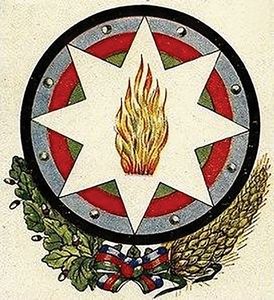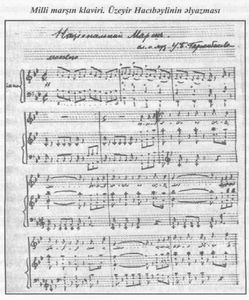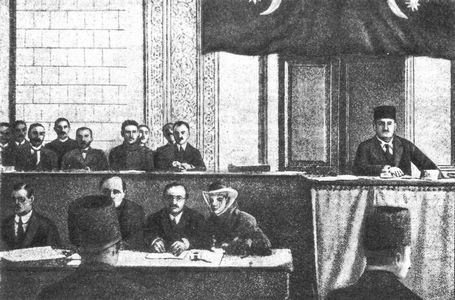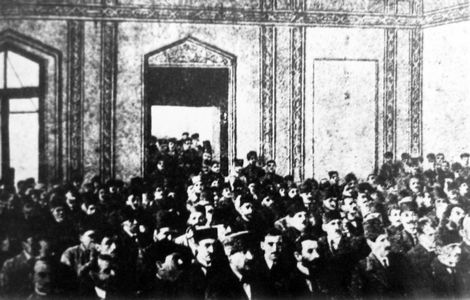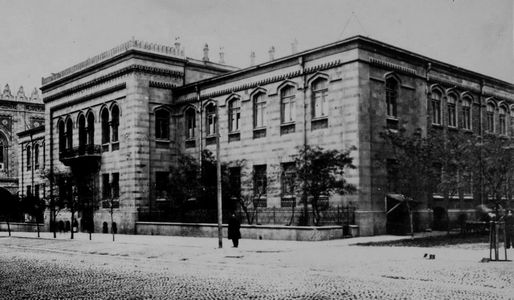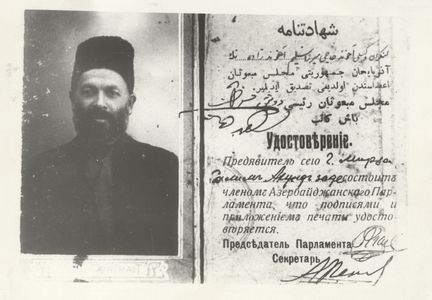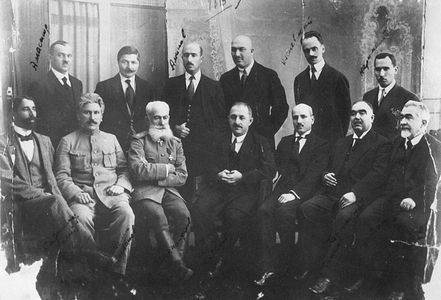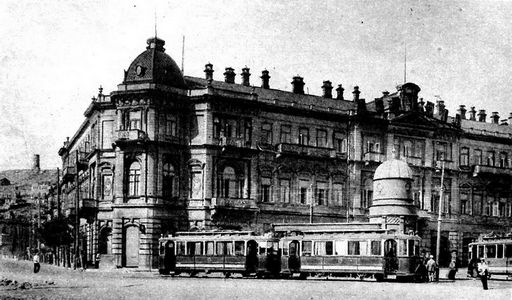State symbols of the Republic of Azerbaijan
“……the three-colored flag was raised by the National Council; the three-colored
flag is the symbol of Turkic freedom, Islamic culture and modern European power
will always wave and be higher over us. The flag once raised will never fall.”
Mammad Emin Rasulzadeh
The State Flag. On November 9, 1918 The Government session adopted the new State Flag. It was to be “green, red and blue colors, white crescent and eight- pointed star.” The green color on the flag symbolized Islam, red- modern ideology of freedom, blue-Turkism. Although the national flag of the republic was abolished as a result of the April occupation (1920), it played a major role in the struggle of the Azerbaijani people for independence. When the liberation movement began in 1988, the tricolor flag was raised again. On November 17, 1990, at the 1st session of the Supreme Mejlis of the Nakhchivan Autonomous Republic heading by Heydar Aliyev, the tricolor state flag of the Republic of Azerbaijan was adopted as the state flag of the Nakhchivan Autonomous Republic. On February 5, 1991, the tricolor flag was declared the State Flag of the Republic of Azerbaijan.
The State emblem. The Government of the Republic declared a competition in order to develop the project for the State Emblem on March 23, 1991 Therefore, for the best project was offered a reward of 25, 000 manats. So, among the projects was approved one on a background semicircle shield with image of eight-pointed star, wreath and the symbol of fire resting on it. The official announcement of the results of the competition was scheduled for May 28, 1920 However, the occupation of Azerbaijan by Soviet Russia on April 27, 1920 prevented it. According to the constitutional law of January 19, 1993 the project of 1920 (with amendment) was declared the State Emblem of the Republic of Azerbaijan.
The National Anthem. The Government carried out a decision on the development the National Anthem on January 30, 1920 However, for the best project was offered a reward of 50, 000 manat. During the state events, parades and lineups in the the military units of Azerbaijan was used Uzeyir Bey Hajibeyli’s “National march” (“Azerbaijan march”). The results of the competition was expected to be declared on May 28 However, the occupation of Azerbaijan on April 27, 1920 made it impossible to accept officially the National Anthem. According to the decree of 27 May, 1992 U.Hajibeyli’s “Azerbaijan march” was approved as the National Anthem. Furthermore, the special attention was drawn on the creation of other state symbols, including the State stamp, order and medal.
Parliament of Azerbaijan Republic
On November 19, 1918 in conformity with the law “on the formation of the Azerbaijan Parliament (Majlisi - Mabusan)” adopted by the National Azerbaijan Council was formed the Parliament of Azerbaijan Republic. The parliament which consisted of 120 deputies, allocated seats among the representatives of people residing in the territory of Republic: Azerbaijanis- 80 deputy seats, Armenians-21 seats, Russsians-10 seats, and one seat each allocated to the National committees of Jewish, Germans, Georgians and Polish; 3 seats for trade union of Baku and two seats for Baku oil industrialists union.
At the end of 1919 in the Parliament were represented 11 factions and 96 parliamentary members: Party “Musavat” and faction of non-adhering - 38 deputies, “Ittihad”- 13 deputies, “Akhrar”- 6 deputies, faction of socialists - 13 deputies, non-party members – 4 deputies, independent- 1 deputy, “Slavic- Russian society” – deputies, Armenian faction - 5 deputies, Armenian party “Dashnaktsutsyun” - 6 deputies.
Furthermore, under the law the deputy of the Parliament would not merely be a government official.
The session of the first Parliament in the Orient, Muslim and Turkic world was held on December 7, 1918 The chairman of the National Council Mahammad Emin Rasulzadeh delivered a welcome speech. The chairman of the Parliament was elected Alimardan Bey Topchubashov, his first Vice-Chairperson became Hasan Bey Aghayev (until February, 1920), Mammad Yusif Jafarov (since February 20, 1920 until the fall of Republic). The secretariat was composed of three members headed by Mahti Bey Hajinski.
As a result of the fact that Azerbaijan Republic was the first parliamentary republic, so the chairman of the Parliament was the head of the state.
So, for 17 - months activity the Parliament held 145 meetings. There had been discussed issues concerning to internal and external policy, economic and financial standing, military building and etc. Thus, the draft laws raised in the session discussions were mainly adopted after the third debate.
During a parliamentary session, before the Parliament was presented more than 270 draft laws and 230 of which were adopted. Draft laws were first debated in the relevant commissions of the Parliament. In total, in the Parliament were acted 11 commissions. The act of the Parliament was regulated by the Parliament Statute which had been prepared by a special committee headed by Qara Bey Qarabeyli.
So, a specialized squad commando unit was set up for guarding the Parliament of Azerbaijan. Commander Lieutenant Naghi Bey Aliyev being the participant of the World War I and campaign of the Azerbaijan Caucasian Army in the ranks of Azerbaijan (Tatar) Cavalry regiment was appointed to the post of commander of the squad.
The last session of the Parliament was held on 27 April, 1920. During its activity, the Parliament showed significantly greater efficiency and capacity while reaffirming that Azerbaijani nation, indeed, had achieved the parliamentary form of government. Nevertheless, as a result of the April occupation, the activity of the Parliament was terminated, the Parliament of the Azerbaijan Republic played a significant role in the history of statehood as well as Azerbaijani nation’s socio-political thought.
Azerbaijan National Council. Azerbaijan National Council was legislative body with executive power, which included delegated deputies, elected by Turkic-Muslim population of the South Caucasus, in order to participate in All-Russian Parliament after the February revolution (1917). Azerbaijan National Council was forced to terminate its activity, and restored it on November 16, 1918.
In 1918, during the session was adopted the law on formation of the Parliament. As a consequence, once the Azerbaijan Parliament launched its function as legislative body, the National Azerbaijan Council was abolished.
Government of Azerbaijan Republic
General information about the Government of the Republic of Azerbaijan.
The Government of the Republic of Azerbaijan was a supreme executive authority of the Republic of Azerbaijan that was in charge of the Parliament.
Furthermore, activity of the Government was undertaken by the Governance affairs authority. Heads of the Governance had been sequentially Rustam Khan Khoyski, Rashid Bey Akhundzadeh, Parviz Mirza.
The official press organ of the Government of the Republic of Azerbaijan was the newspaper “Azerbaijan”. Thereby, in another newspaper of the Government – “Izvestia of the Government of the Republic of Azerbaijan” and in the collection of regulation code “Collection of laws and legal codes of the Government of the Republic of Azerbaijan” were issued regulatory enactments.
In accordance with Decree of the Government on March 3, 1919, was established Azerbaijan Telegraph Agency (AzerTAj).
2nd - 5th government offices of the Republic of Azerbaijan.
Second Cabinet: some changes took place in 06.10.1918
Chairman of the Council of Ministers - F. Khoyski
Minister of Trade, Industry and Internal Affairs – B. Javanshir
Minister of Foreign Affairs - A.M.Topchubashov
The Minister of Finance - M.Hajinski
Minister of Public Education - N.Yusifbeyli
Minister of Transportation- H. Khasmammadov
Minister of Agriculture - H. Sultanov
Minister of Public Healthcare - K. Rafibeyli
Minister of Postal Service and Telegraph - A. Ashurov
Minister of social welfare and religious affairs - M.Rafiyev
Commissioner on Military Affairs - G.Ziyadkhan
State Controller - A.Amirjanov
Third Cabinet: 24.12.1918 -14.03.1919
Chairman of the Council of Ministers and Minister of Foreign Affairs - F. Khoyski
Minister of Internal Affairs - H.Khasmamedov
Minister of Finance - G.Protasov
Minister of Transportation - H.Melikaslanov
Minister of Justice - T.Makinski
Minister of Education and religious affairs - N.Yusifbeyli
Minister of Postal Service, Telegraph and Labor - A.Safikurdski
Minister of military - S.Mehmandarov
Minister of Social Welfare - R.Khoyski
Minister of Public Healthcare - E.Gindes
Minister of Trade and Industry - M.Asadullayev
State Inspector - M.Hajinski (from 16.01.1919 – A. Hasanov)
Minister of food provisions - K.Lisgar
Minister of agriculture - H.Sultanov
Fourth Cabinet: 14.03.1919-26.12.1919
Chairman of the Council of Ministers and Minister of Internal Affairs - N.Usubbekov
Minister of Finance - Ali Hasanov
Minister of Trade and Industry - A.Aminov
Minister of Foreign Affairs - M.Y. Jafarov
Minister of Transportation - H.Melikaslanov
Minister of Postal service and Telegraph - J.Hajinski
Minister of Military - S.Mehmandarov
Minister of Social Welfare - V.Klenevski
Minister of Public Healthcare - A.Dastakov
Minister of Education and religious affairs - R.Kaplanov
Minister of Agriculture - A.Gardashov
Minister without portfolio - H.Amaspyur
State Controller - N.Narimanbeyli
Minister of Justice and Labor - A.Safikurdski
Later Minister of Internal Affairs - H.Khasmamedov
Fifth Cabinet: 24.12.1919 – 01.04.1920
Chairman of the Council of Ministers - N.Usubbekov
Minister of Foreign Affairs - F. Khoyski
Minister of Military - S.Mehmandarov
Minister of Internal Affairs - M.Gajinski (from 18.02.1920 M.Vekilov)
Minister of Justice - H.Khasmammadov
Minister of Finance - R.Kaplanov
Minister of Public Education and religious affairs - H.Shahtakhtinski (from 05.03.1920 - Shahsuvarov)
Minister of labour and agriculture - A.Pepinov
Minister of transportation, concurrently acting temporary Minister of Trade, Industry and Food provisions - H.Melikaslanov (from 18.02.1920 M.Hajinski Minister of Trade, Industry and food provisions)
Minister of Postal service and Telegraph - J.Hajinski
Minister of Social welfare and Health - M.Rafiyev
State Controller - H.Mamedbeyov
Structure of the Government of the Republic of Azerbaijan
The Ministry of Internal Affairs was responsible for ensuring security and public safety, law-abiding and implementation of legal norms.
The Ministry of Internal Affairs played an important role in the prevention of anarchy, enforcement of laws, providing personal and property security of citizens, and fighting crime.
Thus, oversight all judicial and legal system in the Republic of Azerbaijan was undertaken by the Ministry of Justice. Thereby, while also ensuring the creation of the law-enforcement bodies, the Ministry played a significant role in the preparation of statutory acts and its implementation.
Official Extraordinary Investigation Commission was competent to investigate crimes of armenian dashnaks committed against life and property of Azerbaijani people. In order to form an independent judiciary, was established an important state structure - the Trial Chamber of Azerbaijan. Alakbar Bey Khasmammadov was appointed the chairman, and a lawyer Oleg Krichinsky was Chamber prosecutor.
In order to prevent crimes against the state, as well as prevention of espionage and providing intelligence work had been established intelligence agencies, counterintelligence and security.
It was a department of intelligence and counterintelligence of the General Staff, afterwards the Organization to fight counter-intelligence, from March 1920 information department of Baku governor-general.
The Ministry of Postal service and Telegraph was a supreme executive authority that was responsible for the establishment and operation of communication systems.
By the end of 1919, it had 54 post and telegraph offices, as well as one international telegraph station in the territory of Azerbaijan. Upon instructions from the Government, the Ministry of Postal service and Telegraph on October 20, 1919 established the national postal stamps. Artist Zeynal Alizadeh was the author of the project.
The Ministry of Health was a supreme executive authority, governing the establishment and activities of the health care system. Revision Investigation Commission was a special body to investigate crimes in government establishments including abuse of authority and breaches of administrative regulations.
During the period of the Republic of Azerbaijan the Ministry of Transportation was a supreme executive authority in the organization of transport of people and loads, as well as the operation of roads.
By the end of 1919, the structure of the Ministry included governance affairs, railway management, waterways and highways management, Baku school of navigation, control the security of railways, control of backfill of Bibi-Heybat bay. The authority providing the oversight over the execution of decisions of government structures in the country was the Ministry of State Control.
“Decree on Azerbaijan Citizenship” was one of the most important documents adopted by the Government of the Republic of Azerbaijan.


